Korg SP-250 User Manual

Digital Piano
Piano Numérique
Digital-Piano
Pianoforte Digitale
Userʼs Manual Mode dʼemploi Bedienungseinleitung Manuale dʼistruzioni
ENGLISH
FRANÇAIS
DEUTSCH
ITALIANO

English
User’s Manual
Français
Mode d’emploi
Deutsch
Bedienungseinleitung
Italiano
Manuale di istruzioni
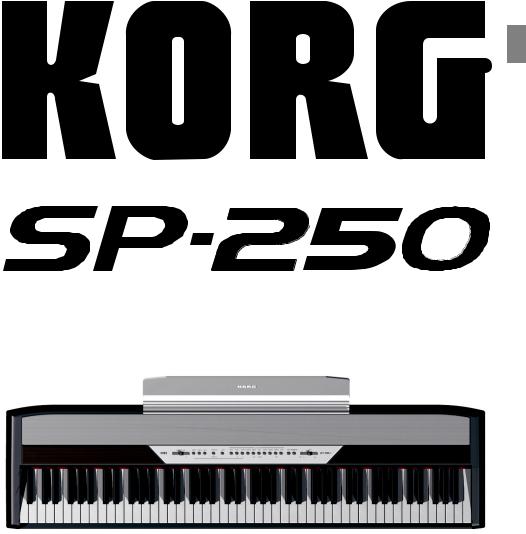
User’s Manual

PRECAUTIONS
Location
Using the unit in the following locations can result in a malfunction.
•In direct sunlight
•Locations of extreme temperature or humidity
•Excessively dusty or dirty locations
•Locations of excessive vibration
Power supply
Please connect the designated AC adapter to an AC outlet of the correct voltage. Do not connect it to an AC outlet of voltage other than that for which your unit is intended.
Interference with other electrical devices
This product contains a microcomputer. Radios and televisions placed nearby may experience reception interference. Operate this unit at a suitable distance from radios and televisions.
Handling
To avoid breakage, do not apply excessive force to the switches or controls.
Care
If the exterior becomes dirty, wipe it with a clean, dry cloth. Do not use liquid cleaners such as benzene or thinner, or cleaning compounds or flammable polishes.
Keep this manual
After reading this manual, please keep it for later reference.
Keeping foreign matter out of your equipment
•Never set any container with liquid in it near this equipment. if liquid gets into the equipment, it could cause a breakdown, fire, or electrical shock.
•Be careful not to let metal objects get into the equipment. If something does slip into the equipment, unplug the AC adapter from the wall outlet. Then contact your nearest Korg dealer or the store where the equipment was purchased.
CE MARK FOR EUROPEAN HARMONIZED STANDARDS
The CE mark that is attached to our company’s products of AC mains operated apparatus until December 31, 1996 means it conforms to the EMC Directive (89/336/EEC) and to the CE mark Directive (93/68/EEC).
The CE mark that is attached after January 1, 1997 means it conforms to the EMC Directive (89/336/EEC), to the CE mark Directive (93/68/ EEC) and to the Low Voltage Directive (73/23/ EEC).
In addition, the CE mark that is attached to our company’s products of Battery operated apparatus means it conforms to the EMC Directive (89/336/ EEC) and to the CE mark Directive (93/68/EEC).
THE FCC REGULATION WARNING (FOR THE U.S.A. ONLY)
This equipment has been tested and found to comply with the limits for a Class B digital device, pursuant to Part 15 of the FCC Rules. These limits are designed to provide reasonable protection against harmful interference in a residential installation. This equipment generates, uses, and can radiate radio frequency energy and, if not installed and used in accordance with the instructions, may cause harmful interference to radio communications. However, there is no guarantee that interference will not occur in a particular installation. If this equipment does cause harmful interference to radio or television reception, which can be determined by turning the equipment off and on, the user is encouraged to try to correct the interference by one or more of the following measures:
•Reorient or relocate the receiving antenna.
•Increase the separation between the equipment and receiver.
•Connect the equipment into an outlet on a circuit different from that to which the receiver is connected.
•Consult the dealer or an experienced radio/TV technician for help.
4

Unauthorized changes or modification to this system can void the user’s authority to operate this equipment.
DISCLAIMER
The information contained in this manual has been carefully revised and checked through. Due to our constant efforts to improve our products, the specifications might differ to those in the manual. Korg is not responsible for any eventual differences found between the specifications and the contents of the instruction manual - the specifications being subject to change without prior notice
WARRANTY
KORG products are manufactured according to the strictest electrical and mechanical regulations that exist in various countries of the world. These products are warranted by the KORG distributor only in each country. Any KORG product that is not sold with the manufacturer’s or distributor’s warranty, or without a serial number, cannot benefit from servicing under the warranty. This regulation is for the consumer’s own protection.
ASSISTANCE AND SERVICE FOR MUSICIANS
For repairs, contact your nearest Authorized KORG Service Center. For more information on KORG products, and to find software and accessories for your piano, please contact your local Authorized KORG distributor.
KORG ON THE INTERNET
Home page Korg Inc.: “http://www.korg.co.jp”
Home page Korg USA: “http://www.korg.com”
Home page Korg Italy: “http://www.korgpa.com”
DATA RESET
When the instrument is turned off, all parameters are reset.
© 2005 Korg Italy Spa. Printed in China.
5

CONTENTS
Introduction . . . . . . . . . . . . . . . . . . . . . . . . . . . . . . . . . . . . . . . . . . . . . . . . . . . . . . . . . . . . . . 7
Main features . . . . . . . . . . . . . . . . . . . . . . . . . . . . . . . . . . . . . . . . . . . . . . . . . . . . . . . . . . . . . . . . . . . . .7
1 Panels . . . . . . . . . . . . . . . . . . . . . . . . . . . . . . . . . . . . . . . . . . . . . . . . . . . . . . . . . . . . . . . . . . 9
Front panel . . . . . . . . . . . . . . . . . . . . . . . . . . . . . . . . . . . . . . . . . . . . . . . . . . . . . . . . . . . . . . . . . . . . . . .9 Rear panel . . . . . . . . . . . . . . . . . . . . . . . . . . . . . . . . . . . . . . . . . . . . . . . . . . . . . . . . . . . . . . . . . . . . . .11
2 Before you begin . . . . . . . . . . . . . . . . . . . . . . . . . . . . . . . . . . . . . . . . . . . . . . . . . . . . . . . . . 12
Connecting to an external amplification system . . . . . . . . . . . . . . . . . . . . . . . . . . . . . . . . . . . . . . . . .12 Using the headphones . . . . . . . . . . . . . . . . . . . . . . . . . . . . . . . . . . . . . . . . . . . . . . . . . . . . . . . . . . . . .12 Turning the instrument on . . . . . . . . . . . . . . . . . . . . . . . . . . . . . . . . . . . . . . . . . . . . . . . . . . . . . . . . . .13 Turning the internal speakers on or off . . . . . . . . . . . . . . . . . . . . . . . . . . . . . . . . . . . . . . . . . . . . . . . .13 Adjusting the volume . . . . . . . . . . . . . . . . . . . . . . . . . . . . . . . . . . . . . . . . . . . . . . . . . . . . . . . . . . . . . .13 Listening to the Demo . . . . . . . . . . . . . . . . . . . . . . . . . . . . . . . . . . . . . . . . . . . . . . . . . . . . . . . . . . . . .13
3 Basic functions . . . . . . . . . . . . . . . . . . . . . . . . . . . . . . . . . . . . . . . . . . . . . . . . . . . . . . . . . . 16
Playing a single sound (Single mode) . . . . . . . . . . . . . . . . . . . . . . . . . . . . . . . . . . . . . . . . . . . . . . . . .16 Playing two sounds at the same time (Layer mode) . . . . . . . . . . . . . . . . . . . . . . . . . . . . . . . . . . . . . .16 Choosing the reverb and the chorus . . . . . . . . . . . . . . . . . . . . . . . . . . . . . . . . . . . . . . . . . . . . . . . . . . .17 The damper pedal . . . . . . . . . . . . . . . . . . . . . . . . . . . . . . . . . . . . . . . . . . . . . . . . . . . . . . . . . . . . . . . .18 The metronome . . . . . . . . . . . . . . . . . . . . . . . . . . . . . . . . . . . . . . . . . . . . . . . . . . . . . . . . . . . . . . . . . .18
4 Other functions . . . . . . . . . . . . . . . . . . . . . . . . . . . . . . . . . . . . . . . . . . . . . . . . . . . . . . . . . . 21
Touch settings . . . . . . . . . . . . . . . . . . . . . . . . . . . . . . . . . . . . . . . . . . . . . . . . . . . . . . . . . . . . . . . . . . .21 Transpose . . . . . . . . . . . . . . . . . . . . . . . . . . . . . . . . . . . . . . . . . . . . . . . . . . . . . . . . . . . . . . . . . . . . . . .22 Fine tuning . . . . . . . . . . . . . . . . . . . . . . . . . . . . . . . . . . . . . . . . . . . . . . . . . . . . . . . . . . . . . . . . . . . . . .22 Selecting a temperament . . . . . . . . . . . . . . . . . . . . . . . . . . . . . . . . . . . . . . . . . . . . . . . . . . . . . . . . . . .23
5 MIDI . . . . . . . . . . . . . . . . . . . . . . . . . . . . . . . . . . . . . . . . . . . . . . . . . . . . . . . . . . . . . . . . . . . 25
What is MIDI? . . . . . . . . . . . . . . . . . . . . . . . . . . . . . . . . . . . . . . . . . . . . . . . . . . . . . . . . . . . . . . . . . . .25 What can you do with MIDI? . . . . . . . . . . . . . . . . . . . . . . . . . . . . . . . . . . . . . . . . . . . . . . . . . . . . . . .25 Connections . . . . . . . . . . . . . . . . . . . . . . . . . . . . . . . . . . . . . . . . . . . . . . . . . . . . . . . . . . . . . . . . . . . . .25 Standard MIDI settings . . . . . . . . . . . . . . . . . . . . . . . . . . . . . . . . . . . . . . . . . . . . . . . . . . . . . . . . . . . .26 Selecting the transmission channel . . . . . . . . . . . . . . . . . . . . . . . . . . . . . . . . . . . . . . . . . . . . . . . . . . .26 Using the SP-250 as a multitimbral tone generator . . . . . . . . . . . . . . . . . . . . . . . . . . . . . . . . . . . . . . .27 Local On/Off . . . . . . . . . . . . . . . . . . . . . . . . . . . . . . . . . . . . . . . . . . . . . . . . . . . . . . . . . . . . . . . . . . . .28 Program Change . . . . . . . . . . . . . . . . . . . . . . . . . . . . . . . . . . . . . . . . . . . . . . . . . . . . . . . . . . . . . . . . .28 Control Change . . . . . . . . . . . . . . . . . . . . . . . . . . . . . . . . . . . . . . . . . . . . . . . . . . . . . . . . . . . . . . . . . .30 MIDI Data Dump . . . . . . . . . . . . . . . . . . . . . . . . . . . . . . . . . . . . . . . . . . . . . . . . . . . . . . . . . . . . . . . . .30
6 Assembling the stand . . . . . . . . . . . . . . . . . . . . . . . . . . . . . . . . . . . . . . . . . . . . . . . . . . . . . 33
Cautions for assembly . . . . . . . . . . . . . . . . . . . . . . . . . . . . . . . . . . . . . . . . . . . . . . . . . . . . . . . . . . . . .33 Assembling procedure . . . . . . . . . . . . . . . . . . . . . . . . . . . . . . . . . . . . . . . . . . . . . . . . . . . . . . . . . . . . .34 Check after assembly . . . . . . . . . . . . . . . . . . . . . . . . . . . . . . . . . . . . . . . . . . . . . . . . . . . . . . . . . . . . . .39 Caution . . . . . . . . . . . . . . . . . . . . . . . . . . . . . . . . . . . . . . . . . . . . . . . . . . . . . . . . . . . . . . . . . . . . . . . . .39
7 Appendix . . . . . . . . . . . . . . . . . . . . . . . . . . . . . . . . . . . . . . . . . . . . . . . . . . . . . . . . . . . . . . . 40
Troubleshooting . . . . . . . . . . . . . . . . . . . . . . . . . . . . . . . . . . . . . . . . . . . . . . . . . . . . . . . . . . . . . . . . . .40 Polyphony . . . . . . . . . . . . . . . . . . . . . . . . . . . . . . . . . . . . . . . . . . . . . . . . . . . . . . . . . . . . . . . . . . . . . .40 Technical specifications . . . . . . . . . . . . . . . . . . . . . . . . . . . . . . . . . . . . . . . . . . . . . . . . . . . . . . . . . . . .41
Control panel shortcuts . . . . . . . . . . . . . . . . . . . . . . . . . . . . . . . . . . . . . . . . . . . . . . . . . . . . 42 Control panel and keyboard . . . . . . . . . . . . . . . . . . . . . . . . . . . . . . . . . . . . . . . . . . . . . . . . 42 MIDI Implementation Chart . . . . . . . . . . . . . . . . . . . . . . . . . . . . . . . . . . . . . . . . . . . . . . . . 172
6 |
Contents |

INTRODUCTION
Introduction
Main features
Wide range of sounds. Thirty different and expressive high-quality sounds, including a Stereo Concert Grand Piano. You can use the Layer function to simultaneously play two sounds.
Effects. The SP-250 provides built-in digital effects that can simulate the natural ambience of a concert hall (Reverb) and add richness to the sound (Chorus).
Damper pedal simulation. The Damper pedal on the SP-250 corresponds to the Damper or Forte pedal of an acoustic piano. On an acoustic piano, when you press this pedal, the pads (dampers) that stop the vibrations of the strings are lifted.
Metronome. The built-in metronome allows you to select the time signature, tempo, and volume, and even use a bell sound as the accent.
Touch control. You can choose from three different settings to adjust how the sound will respond to your keyboard playing dynamics.
Temperaments. In addition to the Equal temperament, the SP-250 allows you to select two alternative classical temperaments (Kirnberger and Werckmeister) for historically accurate performance of classical music. When selecting an acoustic piano sound, the typical Stretched Tuning is automatically selected.
Adjustable pitch. The Transpose function lets you change the pitch of the piano, and the Pitch Control function allows you to make fine tune adjustments.
MIDI capabilities. The SP-250 supports the MIDI protocol, the standard that allows music data to be transferred between musical instruments and computers. MIDI allows two or more devices to control or be controlled by each other, and also allows you to use the SP-250 as a 16-part multitimbral tone generator.
Introduction |
7 |

Powerful integrated amplification. SP-250 includes a powerful, 11 Watt amplier, with two 10cm speakers in Bass Reflex box.
Two sets of heaphones. You can connect two stereo headphones, to play with your teacher or another musician.
8 |
Introduction |
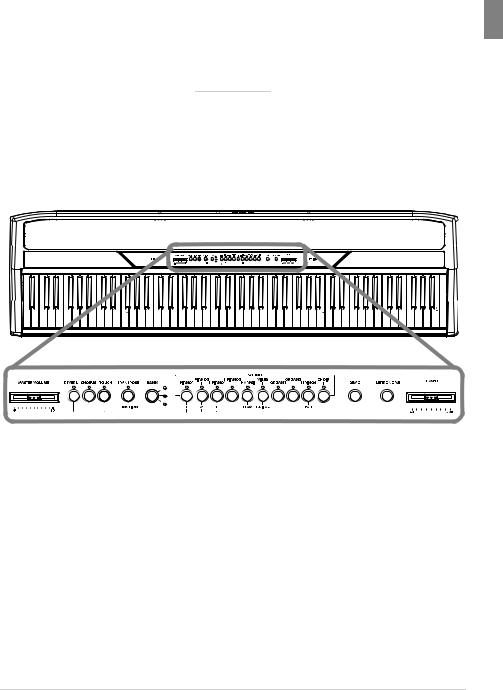
CHAPTER
1
Panels
Front panel
1 |
1 |
2 |
3 |
4 567 8 9 |
0 |
A B C |
1SPEAKERS: Listen to the piano sound from these powerful speakers. To turn them off, insert a jack in one of the PHONES connectors.
2PHONES connector: Connect one or two pairs of headphones to these jacks. The integrated speakers will turn off.
3 POWER switch: On/off switch.
4MASTER VOLUME slider: Adjusts the volume for the speakers, the Output and the Phones connectors.
5 REVERB button: Turns the reverb on/off. This adds ambience to the sound.
6 CHORUS button: Turns the chorus on/off. This makes the sound richer.
Panels |
9 |

7 TOUCH button: Lets you select the keyboard sensitivity.
8 TRANSPOSE/FUNCTION button: Multifunction button to be used in order to modify the transpose and fine tuning functions, to program the MIDI parameters and to carry on other adjustments.
Note: When the instrument is turned off, all parameters are reset.
9 BANK button: Selects one of the 3 available banks of sounds.
0 SOUND SELECTION buttons: Press a button to select a sound (Single mode). You can press two buttons at the same time, to play two sounds at the same time on the keyboard (Layer mode).
ADEMO button: Turns the demo mode on/off, to listen to the demo songs. Select the songs with the sound selection buttons (see above).
B METRONOME button: Turns the metronome click on/off.
C TEMPO slider: Adjusts the metronome tempo.
10 |
Chapter 1 |
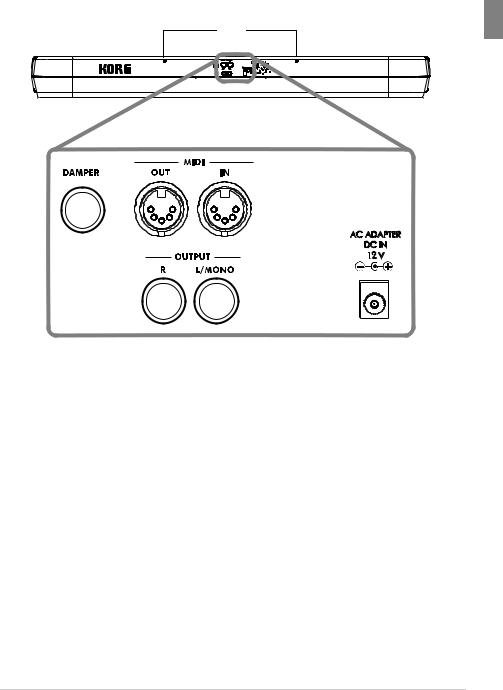
Rear panel
1
3
2
4
5

1 Music stand holes: Insert the music stand into these two holes. Please note that, the first times you use the music stand, you will need to apply some force to insert or remove it. Later, the rubbery plastic material of which the holes are made will adapt to the music stand, making the operation easier to carry on.
2 DAMPER connector: Connect the supplied pedal to this connector.
3 MIDI (IN, OUT) connectors: Connectors that are used to connect other MIDI devices (sequencer, keyboards, etc.). OUT: Data output (to be connected to the MIDI IN connector of another MIDI device). IN: Data input (to be connected to the MIDI OUT connector of another MIDI device).
4OUTPUT (L/MONO, R) connectors: Audio outputs. Connect these connectors to an external amplifying system. (With a hi-fi system use the AUX or TAPE connectors, not the PHONO connector). To amplify the SP-250 in mono, connect the single L/MONO connector. Use the MASTER VOLUME slider to set the output volume.
5 AC ADAPTER connector: Connect the supplied AC/DC adapter to this connector.
Panels |
11 |
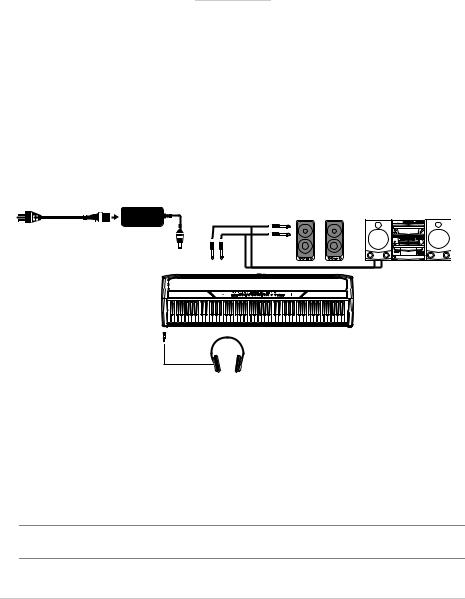
CHAPTER
2
Before you begin
Connecting to an external amplification system
Use the OUTPUT connectors, if you like to connect your SP-250 to a high-quality mixer, stereo hi-fi, or a couple of active monitors. When using a stereo hi-fi, connect the OUTPUTs to the AUX or TAPE inputs (never use the PHONO inputs). For mono amplification, connect only the L/MONO output.
AC adapter |
|
Mini component/ |
(Power cable for AC adapter) |
Powered |
|
L/MONO |
monitors, etc. |
stereo, etc. |
to an AC outlet |
|
|
R |
|
|
DC IN |
|
|
12 V |
|
AUX IN |
|
|
Headphones
Using the headphones
For playing or practicing during night hours, or when you don’t want to be heard by others in the same room, connect one or two pairs of high-quality headphones (32Ω impedance suggested) to the appropriate PHONES connectors. These connectors are standard 1/4” phone jacks. If your headphones have a mini-jack adapter, grasp the adapter when plugging in or out the headphones.
Warning: When using headphones, protect your hearing by avoiding extended listening at high volumes.
12 |
Chapter 2 |
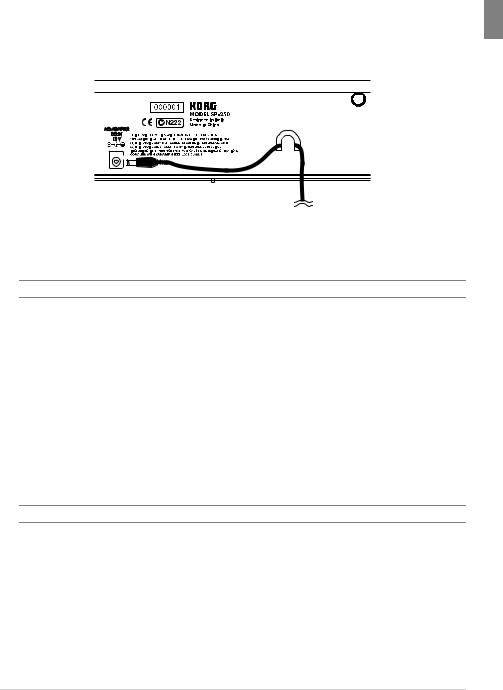
Turning the instrument on
Insert the DC plug of the supplied AC adapter into the DC inlet of the SP-250, then connect the AC plug to a wall socket. You can use the dedicated hook to fix the power cable to the piano’s back panel, as shown in the following illustration:
After having connected the power cable, press the POWER switch. When the instrument is turned on, the LEDs on the control panel will light up. To turn the instrument off, press the POWER switch again.
Note: When the instrument is turned off, all parameters are reset.
Turning the internal speakers on or off
Whether you prefer listening to the internal speakers or to an external amplification system, you can turn the internal speakers on or off. Insert a jack (or connect a headphone set) to one of the PHONES connectors to turn the speakers off.
Adjusting the volume
Move the MASTER VOLUME slider towards the right to increase the volume; towards the left to decrease the volume. The maximum is “10”; the minimum (silence) is “0”. This control adjusts the output level of the headphones, the internal speakers and of the OUTPUTs.
Note: It is always better to start with a low volume and then increase gradually.
Listening to the Demo
The SP-250 contains 30 pre-recorded demo songs. Listen to them to experience the rich sound and expressive potential of this instrument.
Listen to all songs at once. You can listen to all demo songs with a single command.
Before you begin |
13 |

1Press the DEMO button (or keep the TRANSPOSE/FUNCTION button pressed, and press E1 on the keyboard). The sound selection buttons LED will blink sequentially from left to right. After a few seconds, playback will begin. All demo songs will be played back. After the last song, the playback will begin again from the first song.
2During playback, you can press a sound selection button to repeat just the current bank of ten demo songs. (There are three banks of ten demo songs each: 1-10, 1120, 21-30).
For example, if you press the CHOIR button while song number 1 is playing, song number 10 will immediately start playing, and the playback will cycle from song 1 through song 10.
3Press the DEMO button to stop the playback and exit the demo mode.
Listen to a specified song. You can select just one demo song to be played back.
1First of all, you must select one of the three demo song banks.
•To select the first bank (1-10), press the DEMO button once. The LEDs will blink sequentially, from left to right.
•To select the second bank (11-20), press the DEMO button a second time. All LEDs will blink at the same time.
•To select the third bank (21-30), press the DEMO button a third time. Adjacent LEDs will blink alternatively
2Press one of the sound selection buttons to select the corresponding song in the selected bank. The LED on the selected demo button will stay on, while the other LEDs will turn off.
After the end of the selected song, all the songs of the selected bank will be played back in cycle.
Button |
Bank 1 (1-10) |
Bank 2 (11-20) |
Bank 3 (21-30) |
|
|
|
|
PIANO 1 |
F. Mendelssohn-Bar- |
Korg Original (M. Tem- |
C.A. Debussy: |
|
tholdy: Prelude Op.104a, |
pia): Reflection |
Arabesque no.1 |
|
no.2 |
|
|
|
|
|
|
PIANO 2 |
F. Chopin: Nocturne |
S. Joplin: The Enter- |
J.S. Bach: Two-voice |
|
Op.9, no.2 |
tainer |
invention no.13 |
|
|
|
|
E.PIANO 1 |
C.A. Debussy: Clair de |
Korg Original (M. Tem- |
F. Chopin: Fantasie- |
|
lune |
pia): Jumper |
Impromptu Op.66 |
|
|
|
|
E.PIANO 2 |
Korg Original (M. Tem- |
Korg Original (M. Tem- |
J.S. Bach: Prelude in C |
|
pia): Lullaby for a Little |
pia): All the Ones You |
major (from Das Wohl- |
|
Star |
Don’t Know |
temeperierte Klavier) |
|
|
|
|
14 |
Chapter 2 |
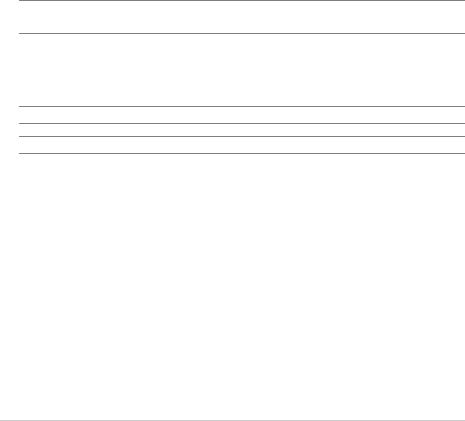
Button |
Bank 1 (1-10) |
Bank 2 (11-20) |
Bank 3 (21-30) |
|
|
|
|
|
|
|
|
HARPSI |
L. van Beethoven: Für |
J.S. Bach: Italian Con- |
Korg Original (M. Tem- |
|
|
/CLAV |
Elise |
cert |
pia): Rubber Bob |
|
|
|
|
|
|
|
|
VIBES |
F. Chopin: Etude Op.10, |
Korg Original (M. Tem- |
R. Schumann: Trauma- |
|
|
/GUITAR |
no.3 |
pia): Jazz in Spain |
rei, Op.15, no.7 |
|
|
|
|
|
|
|
|
ORGAN 1 |
W.A. Mozart: A la turque |
Korg Original (M. Tem- |
F. Mendelssohn-Bar- |
|
|
|
(from the Sonata in A- |
pia): Cool “B” |
tholdy: Spring Song, |
|
|
|
major K.331) |
|
Op.62, no.6 |
|
|
|
|
|
|
|
|
ORGAN 2 |
F. Chopin: Valse no.6 in |
F. Mendelssohn-Bar- |
Korg Original (M. Tem- |
|
|
|
D -major Op.64, no.1 |
tholdy: Wedding March |
pia): Sunflowers |
|
|
STRINGS |
Korg Original (M. Tem- |
J.S. Bach: Air on the G |
P.D. Paradisi: Toccata in |
|
|
/PAD |
pia): Old Feather Blues |
string |
A major |
|
|
|
|
|
|
|
|
CHOIR |
Korg Original (M. Tem- |
Korg Original (M. Tem- |
Korg Original (M. Tem- |
|
|
|
pia): Noise of time |
pia): Voice Texture |
pia): Wet Raccoon Rag |
|
|
|
|
|
|
|
|
3Press the DEMO button to stop the playback and exit the demo mode.
Note: During the demo playback you can’t use the sound selection buttons to select sounds, or the REVERB and CHORUS buttons.
Adjusting the tempo of the demo songs. Use the TEMPO slider to change the tempo of the selected demo song. Normally, the playback tempo of the demo song will not match the markings of the TEMPO slider.
Note: You can’t use the metronome during the demo playback.
Note: When a demo is selected, its original tempo is recalled.
Before you begin |
15 |

CHAPTER
3
Basic functions
Playing a single sound (Single mode)
You can select a sound from the thirty sounds supplied with the instrument.
1Press one of the sound selection buttons in order to select a sound. The LED on the button you pressed will light.
2Use the BANK button to select one of the three available banks (1-10, 11-20, 2130). Pressed a first time it selects Bank 2; pressed a second time it selects Bank 3; pressed a third time it selects Bank 1 again.
Button |
Bank 1 |
# |
Bank 2 |
# |
Bank 3 |
# |
|
|
|
|
|
|
|
PIANO 1 |
Grand Piano |
2 |
Bright Piano |
2 |
Mellow Piano |
2 |
|
|
|
|
|
|
|
PIANO 2 |
Honky-Tonk |
2 |
Detune Piano |
2 |
E.Grand Piano |
1 |
|
|
|
|
|
|
|
E.PIANO 1 |
Club E.Piano |
2 |
Stage E.Piano |
1 |
Thin E.Piano |
2 |
|
|
|
|
|
|
|
E.PIANO 2 |
80's E. Piano |
2 |
Digital E.Piano |
1 |
Vintage E. Piano |
1 |
|
|
|
|
|
|
|
HARPSI/CLAV |
Harpsichord |
1 |
Clav. |
1 |
Wah Clav. |
1 |
|
|
|
|
|
|
|
VIBES/GUITAR |
Vibraphone |
1 |
Marimba |
1 |
Acoustic Guitar |
1 |
|
|
|
|
|
|
|
ORGAN 1 |
Jazz Organ 1 |
2 |
Jazz Organ 2 |
2 |
Jazz Organ 3 |
2 |
|
|
|
|
|
|
|
ORGAN 2 |
Church Organ 1 |
3 |
Church Organ 2 |
1 |
Church Organ 3 |
1 |
|
|
|
|
|
|
|
STRINGS/PAD |
Slow Strings |
2 |
Warm Pad |
2 |
Strings |
1 |
|
|
|
|
|
|
|
CHOIR |
Choir Hoo |
1 |
Choir Doo |
2 |
Choir Pad |
2 |
|
|
|
|
|
|
|
(#) These columns show the number of oscillators per voice used by each sound
Playing two sounds at the same time (Layer mode)
You can play two sounds at the same time on the keyboard. This is called the Layer mode.
16 |
Chapter 3 |

Note: When selecting the Layer mode, the total number of voices that can play at the same time is reduced, depending on the total number of oscillators used by the selected sounds.
Note: You can’t select two sounds included under the same button.
1Press one of the sound selection buttons in order to select the first sound. The LED on the button you pressed will light. Use the BANK button to select a sound in one of the other banks.
2Press another sound selection button to select the second sound. The LED on the button you pressed will light. Use the BANK button to select a sound in one of the other banks.
3Press both buttons at the same time to select the sounds. Both LEDs will light.
Note: Steps 1 and 2 are not required, if the right banks are already selected.
Returning to the Single mode. To return to the Single mode, just press a single sound selection button.
Adjusting the volume of sounds in Layer mode. To adjust the balance between the sounds in Layer mode, hold down the button of the sound whose level you wish to decrease, and repeatedly press the button of the sound whose level you wish to raise.
Note: This setting will be memorized even after turning the Layer mode off, but will be lost when turning the instrument off. To save these settings, save them using the Data Dump function (see “MIDI Data Dump” on page 31).
Choosing the reverb and the chorus
The SP-250 has two effects: reverb and chorus. The reverb simulates the sound reverberation in a room, while the chorus simulates a modulating effect that makes the sounds richer. The effect settings will be remembered even when selecting a different sound.
Note: Effect settings made in Single mode are memorized even when selecting the Layer mode, but no change made in Layer mode will be preserved.
When the instrument is turned on, the effect settings are reset to the factory settings. To save the Single mode settings, save them using the Data Dump function (see “MIDI Data Dump” on page 31).
Basic functions |
17 |

1Hold down the REVERB or CHORUS button, and press either the PIANO 1/L, PIANO 2/M, or E.PIANO1/H sound selection button to select the reverb or chorus depth.
Button |
Reverb depth |
Chorus depth |
|
|
|
PIANO 1/L |
Light reverb |
Light chorus |
|
|
|
PIANO 2/M |
Normal reverb |
Normal chorus |
|
|
|
E.PIANO 1/H |
Deep reverb |
Deep chorus |
|
|
|
2To check the currently selected reverb or chorus depth, hold down the REVERB or CHORUS button, and look at which of the above LEDs is turned on.
3To turn the reverb or chorus off, press the REVERB or CHORUS button. The LED on the button will turn off.
The damper pedal
The supplied pedal can be used as a damper pedal. You can also use the halfpedalling, with a gradual resonance effect depending on the depth of the pedal pressure.
In Layer mode, you can select the sound(s) to apply the pedal to.
Note: When the instrument is turned on, the pedal settings are reset. To save these settings, save them using the Data Dump function (see “MIDI Data Dump” on page 31).
1Hold the TRANSPOSE/FUNCTION button, and press the damper pedal. Each time you press the pedal, the LED on the sound selection button(s) where the damper pedal is active will light.
2When the pedal is assigned to the desired sound(s), release the TRANSPOSE/ FUNCTION button.
The metronome
The SP-250 incorporates a metronome, with which you can set the tempo during practice.
Starting and stopping the metronome. Press the METRONOME button to make the metronome start or stop. When turning on, the metronome is set according to the slider position, but you can adjust it with the procedure described below. After having listened to the demo, the tempo will be that of the last demo that had been listened to.
18 |
Chapter 3 |
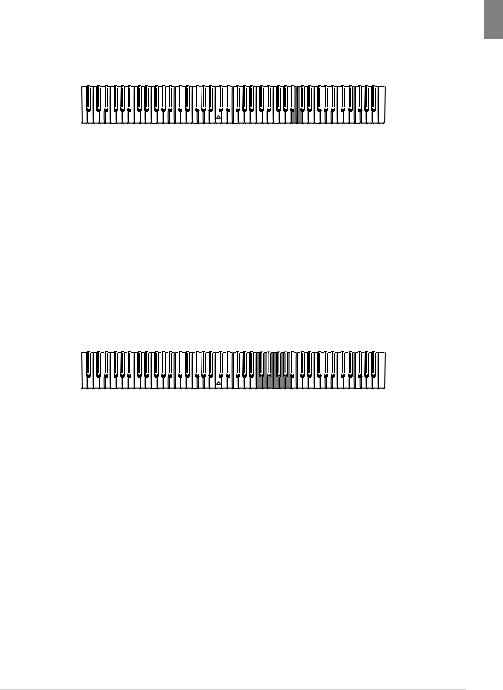
Adjusting the metronome volume. While the metronome is playing, keep the METRONOME button pressed and repeatedly press the STRINGS/PAD button (or the B5 key) to lower the volume, or the CHOIR button (or the C6 key) to raise it. To reset the volume, simultaneously press the STRINGS/PAD and CHOIR buttons (or the B5 and C6 keys on the keyboard) while holding the METRONOME button.
Key |
Effect |
Key |
Effect |
|
|
|
|
B5 |
Lower volume |
C6 |
Higher volume |
|
|
|
|
Adjusting the tempo using the TEMPO slider. Use the TEMPO slider to adjust the tempo. The range is = 40 ~ 200.
Numeric tempo input. In some cases, you may require an exact tempo (like 127 BPM). It is possible to enter a precise tempo, using the numeric input.
1 Hold down the METRONOME button.
2Use the keyboard to input the three-digit tempo value (insert a “0” before a twonumber value).
Key |
Number |
Key |
Number |
|
|
|
|
C5 |
0 |
C#5 |
1 |
|
|
|
|
D5 |
2 |
D#5 |
3 |
|
|
|
|
E5 |
4 |
F5 |
5 |
|
|
|
|
F#5 |
6 |
G5 |
7 |
|
|
|
|
G#5 |
8 |
A5 |
9 |
|
|
|
|
For example, to select a tempo value of 168, keep the METRONOME button pressed, then press C#5 (1), F#5 (6), G#5 (8). To select a tempo value of 85, keep the METRONOME button pressed, then press C5 (0), G#5 (8), F5 (5).
Basic functions |
19 |

Selecting the time signature. You can add an accent to the first beat of a measure.
Button |
Time signature |
|
|
PIANO 1 |
2 movements (2/4, 2/8...) |
|
|
PIANO 2 |
3 movements (3/4, 3/8...) |
|
|
E.PIANO 1 |
4 movements (4/4, 4/8...) |
|
|
E.PIANO 2 |
6 movements (6/4, 6/8...) |
|
|
1While the metronome is working, keep the METRONOME button pressed and press the button that corresponds to the time signature you wish to use (see table above). The first movement of the measure will be accented.
2To deactivate the accent, keep the METRONOME button pressed and press the sound selection button whose LED is lit.
Note: When the instrument is turned on, the accent is automatically disabled.
Selecting a bell for the accent. The accented beat can be changed to a bell sound.
1While the metronome is playing, hold down the METRONOME button, then press the VIBES/GUITAR sound selection button. The LED on the button will light, and a bell sound will be heard on the first beat of the bar.
2To return to the normal accent, hold down the METRONOME button and press the HARPSI/CLAV sound selection button to switch on the LED on the HARPSI/ CLAV button.
Note: When the instrument is turned on, the bell is automatically disabled.
20 |
Chapter 3 |
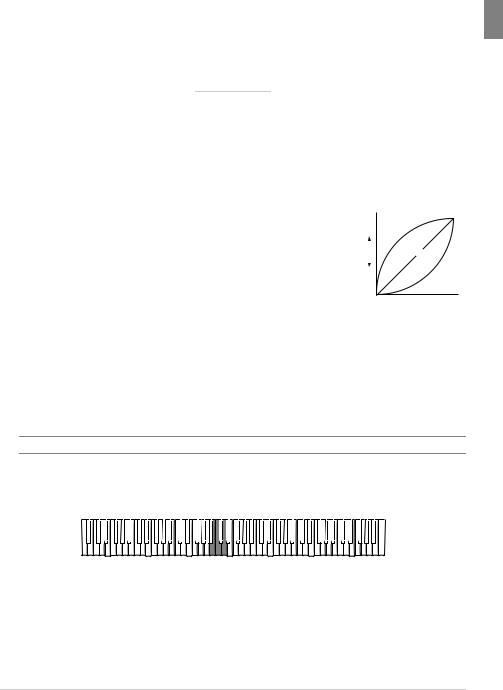
CHAPTER
4
Other functions
Touch settings
The keyboard sensitivity, or touch, can be programmed. Keep the TOUCH button pressed, and press the appropriate button to select one of the available touch settings.
Button |
Touch sensitivity |
|
|
PIANO 1/L |
Light. Loud notes can be produced |
|
even by playing lightly. |
|
|
PIANO 2/M |
Normal. Normal piano touch. |
|
|
E.PIANO 1/H |
Heavy. Loud notes can be pro- |
|
duced only by playing very hard. |
|
|
Strong
( ) Light
Note |
|
Standard |
loudness |
Heavy |
|
|
|
|
|
|
|
Soft ( )
Soft 
 Strong Playing strength
Strong Playing strength
To check the currently selected setting, hold down the TOUCH button, and look at which of the above LEDs is turned on.
Note: When the instrument is turned on, the touch setting is reset to Normal.
Alternatively, you can use the TRANSPOSE/FUNCTION button and the keyboard. Hold the TRANSPOSE/FUNCTION button, and press the key on keyboard that corresponds to the touch setting you wish to carry out (see table).
|
|
|
|
|
|
|
|
|
|
|
|
|
|
|
|
|
|
|
|
|
|
|
|
|
|
|
|
|
|
|
|
|
|
|
|
|
|
|
|
|
|
|
|
|
|
|
|
|
|
|
|
|
|
|
|
|
|
|
|
|
|
|
|
|
|
|
|
|
|
|
|
|
|
|
|
|
|
|
|
|
|
|
|
|
|
|
|
|
|
|
|
|
|
|
|
|
|
|
|
|
|
|
|
|
|
|
|
|
|
|
|
|
|
|
|
|
Key |
Touch sensitivity |
|||||||||||||||||||||||||||||||||||||
|
|
|
|
|
|
|
|
|
|
|
|
|
|
|
|
|
|
|
|
|
|
|
|
|
|
|
|
|
|
|
|
|
|
|
|
|
|
|
B3 |
Light. Loud notes can be produced even by playing lightly. |
|||||||||||||||||||||||||||||||||||||
|
|
|
|
|
|
|
|
|
|
|
|
|
|
|
|
|
|
|
|
|
|
|
|
|
|
|
|
|
|
|
|
|
|
|
|
|
|
|
C4 |
Normal. Normal piano touch. |
|||||||||||||||||||||||||||||||||||||
|
|
|
|
|
|
|
|
|
|
|
|
|
|
|
|
|
|
|
|
|
|
|
|
|
|
|
|
|
|
|
|
|
|
|
|
|
|
|
D4 |
Heavy. Loud notes can be produced only by playing very hard. |
|||||||||||||||||||||||||||||||||||||
|
|
|
|
|
|
|
|
|
|
|
|
|
|
|
|
|
|
|
|
|
|
|
|
|
|
|
|
|
|
|
|
|
|
|
|
|
|
|
Other functions |
21 |
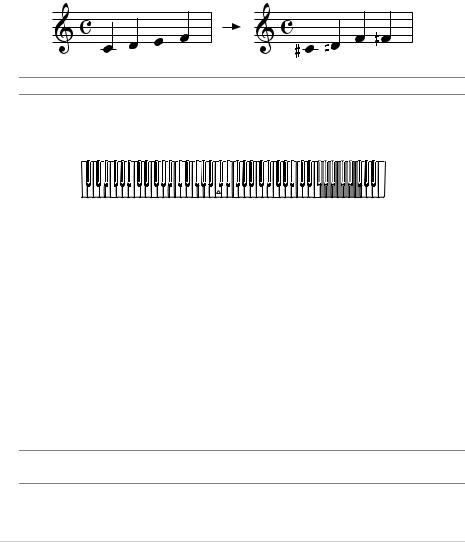
Transpose
In some cases, a song may be written in a difficult key (e.g., many black keys), or you may wish to shift the pitch to match another instrument or vocalist. In such cases, you can transpose (shift the pitch) so that you can use an easier fingering, or use the same familiar fingering to play at a different pitch. This is called the Transpose function.
For example if you transpose upward by one semitone, playing the notes shown at the lower left will produce the pitches shown at the right.
Note: When the instrument is turned on, the transposing is reset.
1Hold the TRANSPOSE/FUNCTION button, and press the key on keyboard that corresponds to the transpose you wish to carry out (see table). The TRANSPOSE/ FUNTION LED will remain lit up, to indicate that the transpose function is active.
Key |
Effect |
|
|
|
|
F#6 — B6 |
6 |
— 1 semitones below |
|
|
|
C7 |
Standard pitch |
|
|
|
|
C#7 — F7 |
1 |
— 5 semitones higher |
|
|
|
2To get back to standard pitch, hold the TRANSPOSE/FUNCTION button and press the C7 key. The TRANSPOSE/FUNCTION LED will turn off.
Fine tuning
In order to adapt the SP-250 pitch to that of another instrument, you can adjust the pitch in steps of 0.5 Hz over a range of A4 = 427.5 ~ 452.5 Hz. The standard tuning is A4 = 440 Hz.
Note: The pitch will go back to standard level (A4 = 440 Hz) when the instrument is turned off, then on again.
22 |
Chapter 4 |

1Hold the TRANSPOSE/FUNCTION button, and press the corresponding key to change the pitch. Each time the B5 or C6 key is pressed, the pitch will be raised or lowered by 0.5 Hz.
2To get back to standard pitch, hold the TRANSPOSE/FUNCTION button and press the B5 and C6 buttons at the same time.
Key |
Fine tuning |
|
|
B5 |
Lowers the pitch by 0.5 Hz |
|
|
B5+C6 |
Standard pitch (A4 = 440 Hz) |
|
|
C6 |
Raises the pitch by 0.5 Hz |
|
|
Selecting a temperament
There are numerous classical compositions that were composed using temperaments that differ from the “equal temperament” commonly used today.In order to reproduce the original sound of such compositions, the SP-250 provides Kirnberger and Werckmeister classical temperaments, in addition to the equal temperament, allowing you to select from a total of three temperaments.
To select one of the available temperaments, hold down the TOUCH button, then press the button corresponding to the desired temperament. To return to the equal tuning hold down the TOUCH button, then press the sound selection button whose LED is lit.
Button |
Temperament |
|
|
Both LEDs |
Equal temperament. Nearly all keyboard instruments today use equal |
turned off |
temperament. This temperament spaces all semitones at equal dis- |
|
tances, and allows identical scales to be played in any key. |
|
|
HARPSI/CLAV |
Werckmeister. This is the Werckmeister III scale invented by Andreas |
|
Werckmeister, the German organist and music theoretician. This scale |
|
was created in the later Baroque period to allow relatively free transposi- |
|
tion. |
|
|
VIBES/GUITAR |
Kirnberger. This is the Kirnberger III scale invented by Johann Phillip |
|
Kirnberger in the early 18th century, and is used mainly for tuning harpsi- |
|
chords. |
|
|
Other functions |
23 |

To check the currently selected temperament, hold down the TOUCH button, and look at which of the above LEDs is turned on.
Note: When the power is turned on, the equal temperament will be automatically selected.
About stretched tuning. In order to produce the most natural resonance, PIANO 1 and PIANO 2 sounds use a “stretched tuning” that makes the notes of the lower range slightly flatter than equal temperament, and the upper range slightly sharper. This is how an acoustic piano is normally tuned by professional tuners.
24 |
Chapter 4 |
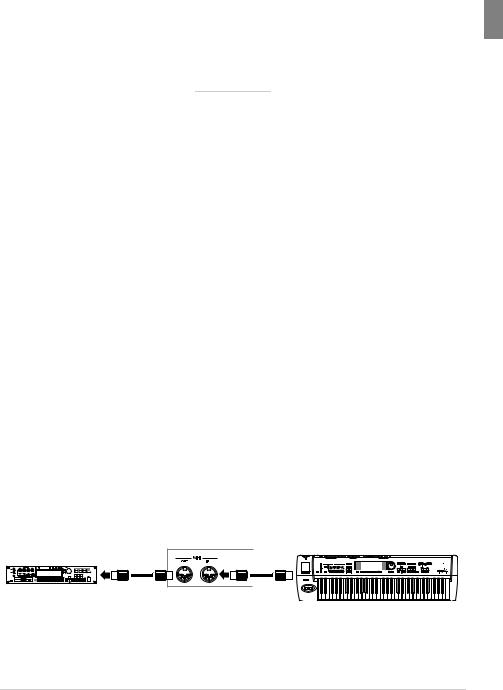
CHAPTER
5
MIDI
What is MIDI?
MIDI, is the abbreviation of Musical Instrument Digital Interface. It is an international standard that was created to connect and transfer data between electronic musical instruments, computers and other devices.
What can you do with MIDI?
Thanks to MIDI, you can use the SP-250 to control other instruments, use other instruments to control the SP-250, and use a sequencer to create complex musical pieces.
When you use the SP-250 keyboard or pedal, or select a sound, the notes, pedal activation and change in sound are transmitted to another instrument, or are recorded by a sequencer.
Connections
Always connect the MIDI OUT connector of the instrument to the MIDI IN connector of another instrument. Never connect two connectors of the same instrument to each other.
Connect the MIDI OUT connector of the transmitting (master) device to the MIDI IN connector of the receiving (slave) device.
SP-250 rear panel |
MIDI keyboard |
MIDI OUT |
MIDI IN
MIDI sound module
To connect the SP-250 to a computer, you need a MIDI interface for the computer, sequencing or musical notation software, and two standard MIDI cables. Connect
MIDI |
25 |
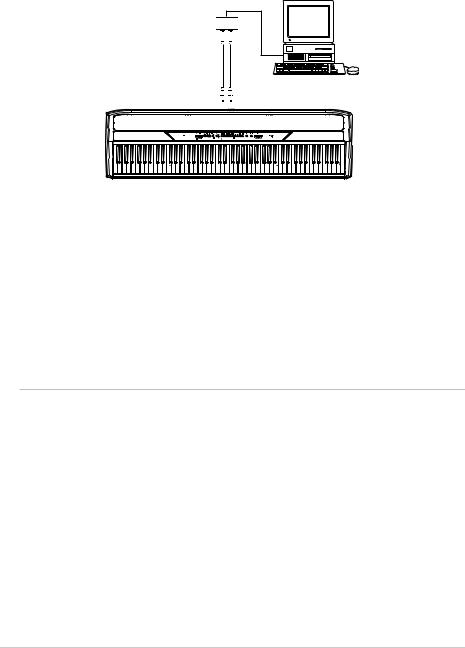
the SP-250 MIDI OUT connector to the MIDI IN connector of the computer. Connect the SP-250 MIDI IN connector to the MIDI OUT connector of the computer.
MIDI OUT 




 MIDI IN
MIDI IN
MIDI IN 
 MIDI OUT
MIDI OUT
Standard MIDI settings
When turning the instrument on, the MIDI parameters of the SP-250 are programmed as follows:
Parameter |
Setting |
|
|
Transmission channel |
1 |
|
|
Reception channel(s) |
All 16 (1-16)* |
|
|
Local |
ON |
|
|
Omni |
OFF |
|
|
(*) On channel 10, only metronome notes are received (D#5, E5).
Selecting the transmission channel
The standard MIDI has 16 separate channels available for transmission and reception of data. SP-250 always receives on all 16 channels, and transmits on a single channel. To transmit data from the SP-250, you need to choose which of the 16 channels you wish to transmit data on.
26 |
Chapter 5 |
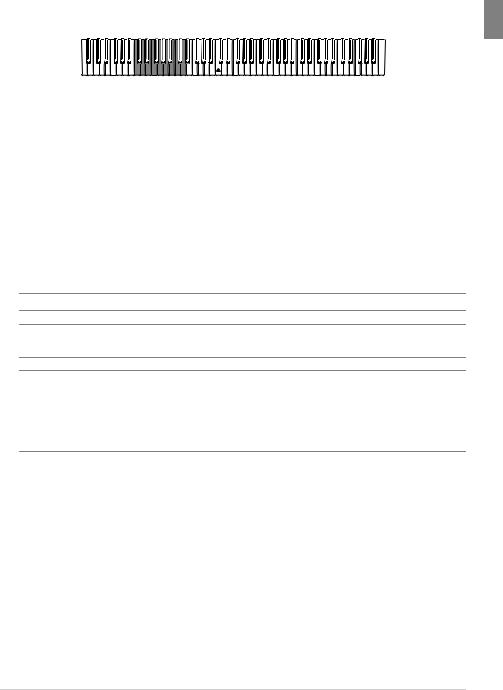
Hold down the TRANSPOSE/FUNCTION button, and press the note in the range C2–D#3 corresponding to the desired MIDI channel.
Key |
Channel |
Key |
Channel |
|
|
|
|
C2 |
1 |
C#2 |
2 |
|
|
|
|
D2 |
3 |
D#2 |
4 |
|
|
|
|
E2 |
5 |
F2 |
6 |
|
|
|
|
F#2 |
7 |
G2 |
8 |
|
|
|
|
G#2 |
9 |
A2 |
10 |
|
|
|
|
A#2 |
11 |
B2 |
12 |
|
|
|
|
C3 |
13 |
C#3 |
14 |
|
|
|
|
D3 |
15 |
D#3 |
16 |
|
|
|
|
Note: When the power is turned on, channel 1 will automatically be selected.
Note: By default, channel 10 will automatically be assigned to the metronome sound (notes D#5-E5).
Note: In Layer mode, the second sound transmits on the following channel. For example, if you select channel 7, the first sound will transmit on channel 7, while the second sound will transmit on channel 8. If you select channel 16, the first sound will transmit on channel 16, while the second sound will transmit on channel 1 (cycling back to the first channel).
Using the SP-250 as a multitimbral tone generator
When SP-250 is controlled from an external MIDI device, it can work as a 16-part multitimbral tone generator.You can select a different sound on each of the 16 MIDI channels.
1Use a MIDI cable to connect the SP-250's MIDI IN to the MIDI OUT of a sequencer etc.
2Transmit MIDI data from the connected sequencer (or other device). See “Program Change” on page 28 for instructions on how to select a sound using the MIDI Program Change message. Program Change reception must be activated on the SP-250 (it is by default).
MIDI |
27 |

Read the other devices user’s manual for details on sending Program Change messages.
Local On/Off
Local is the parameter that allows you to establish whether the keyboard has to play the internal sounds and transmit MIDI data at the same time (Local On), or whether it just has to transmit MIDI data and not play the internal sound (Local Off).
Local Off should be chosen when you wish to use the SP-250 as a mute keyboard, to play another instrument. It should be chosen also when SP-250 is connected to a sequencer via its MIDI IN and MIDI OUT connectors. This will avoid the notes to be played twice, by the keyboard and by the sequencer, producing an annoying “echo” effect.
Normally, you will choose Local On (automatically selected when turning the SP250 on), so that playing the keyboard will produce sound.
Hold down the TRANSPOSE/FUNCTION button, and press the PIANO 1 sound selection button. The Local setting will alternate to On/Off each time you press this button.
Local status |
PIANO 1 LED status |
|
|
Local On |
Lit |
|
|
Local Off |
Dark |
|
|
Note: When the power is turned on, the Local will be automatically set to On.
Program Change
The sound of the SP-250 can be selected via MIDI, by sending a Program Change message on the channel where you wish to assign the sound. The table enlists the Program Change numbers (numbering from 0-29; if the transmitting device uses numbers from 1-30, you will need to increment the number by one).
Transmitting Program Change messages. You can send a MIDI Program Change message to a MIDI device connected to the SP-250 MIDI OUT, to change its sound. When selecting one of the internal sounds of the SP-250 by using the sound selection buttons, a MIDI Program Change number will be transmitted, as shown in the table below.
Receiving Program Change messages. When a Program Change message is received from an external device, the corresponding internal sound will be selected
28 |
Chapter 5 |
